Gymshark is an online-only global retailer of gym clothing and fitness wear based in Solihull in the West Midlands. Set up in 2012 by young entrepreneur Ben Francis, and grown through social media promotions, the retailer had around 850 employees as of 2021.
The business is highly cash generative and does not offer consumer credit, meaning it is well capitalised. It does not normally borrow, but it does have access to revolving credit facilities from lenders if needed, and had a turnover of £400m last year.
Because of its online-only, direct-to-consumer approach, the firm saw good trading and substantial growth through the UK's COVID-19 lockdowns, as consumers sought to maintain their health and mental well-being, and furlough supported discretionary spending.
“People couldn’t buy from shops, so they were buying online from us, and there was a push for fitness,” says Philip Daw, Gymshark Chief Financial Officer. “We also pivoted our brand offering and our connection with our community through social media, and helped our consumers through organising online events and initiatives.”
With UK gyms shutting down, a lot of gym trainers did not have any business or wages.
“We paid personal trainers to do online workout routines, through Instagram, Facebook or YouTube, which worked really well because it gave something back to our industry and customers,” says Daw.
The business is monitoring consumer behaviour as the UK attempts to open up society again in 2022, although Daw cautions that the economy is not yet in its post-COVID-19 cycle.
Growth and challenges
Although the business has grown profitably every year, developing a core online community, it is operating in a market full of well-known giants like Adidas and Nike, meaning it is still targeting growth in the UK domestic market.
Geographically, its biggest growth market is the US, where it has a substantial business and opened an office last year in Denver, with around 120 people.
Other than consumer spending growth challenges from macro-economic factors, the business sees inflation affecting its labour costs, and its logistics delivery costs from third-party courier firms.
“If we look at carriage costs inwards and when delivering to customers in the US with major carriers, they are so busy that they can almost charge what they want for delivery,” says Daw.
Daw says the work-from-home directives have increased the number of drops the couriers need to make, adding to costs passed along the supply chain.
Gymshark is not a fast-fashion business – its stock is designed carefully over many months and stored in warehouses, so it has been insulated from cost shocks, although those storage costs are subject to increase.
“However, for more recent product launches, we’ve been hit by supply-chain shocks, where it’s been very tight to get stock in, and in some cases for new products we’ve not been able to get stock delivered on time on every occasion, which means we need to pivot very quickly.”
The business’s suppliers are spread across several countries, which has helped in limiting disruption to supplies.
“Talking to other financial directors, we haven’t suffered too badly compared with others,” remarks Daw.
Import and export
The business uses third-party logistics firms and had, prior to the pandemic, used a delivery centre in Swindon up until 2018 for all international deliveries.
Post-Brexit, they opened a second delivery centre in Belgium, where their delivery partner Bleckmann Logistics is based – suppliers now deliver to both centres to supply the UK and EU, and the rest of the world markets respectively.
The business opened delivery centres on the West and East Coast of the US last year to prepare for its growth there, as well as in Canada and Australia.
“We haven’t experienced any major problems, although on the West Coast of America there has been some backlog due to the container ships going into LA,” says Daw.
Forward planning
As the business has grown, it has been as agile as possible, although decisions due to uncertainties need to be managed as they fluctuate or occur. Those uncertainties currently span the supply-chain variances; surcharges from delivery partners and the bottleneck caused by the Ever Given container ship in the Suez Canal, says Daw.
“We had no idea of the knock-on effect that one ship blocking one waterway was going to have on the supply chain worldwide. It’s just making decisions at the time: you can’t predict them.”
Rising interest rates from central banks and the reduction of cash in the economy, through rising bills and dropping consumer spending, could be the next risk.
“We have to be mindful as a business of that factor, and plan for if things don’t go quite as well,” adds Daw.
“We have a detailed business plan for the next 18 months, but we have an idea of what our plans are, and what we should be turning over in revenue and profit for the next three years to let us plan.”
The future will involve working on brand awareness: Daw says that US sales could be triple the current level if awareness there was at the same level as it is in the UK.
“The total addressable market that we have worldwide is huge, and we’re a miniscule player compared with Nike and others. For us, there are still many areas that we can target, even in a depressed market.”
This includes plans for launching an experiential store this year on Regent Street – an environment built for the fitness community.
“We want to make it a destination for Gymshark customers,” says Daw. “If we can make that work, we can roll it out in other markets.”
Trade: clean growth and tech
Clean growth and the application of major emerging technologies to existing sectors are two key characteristics of trade in 2022. Add to these levelling up supported by foreign direct investment, and there are exciting future prospects for business and the prosperity of communities globally.




